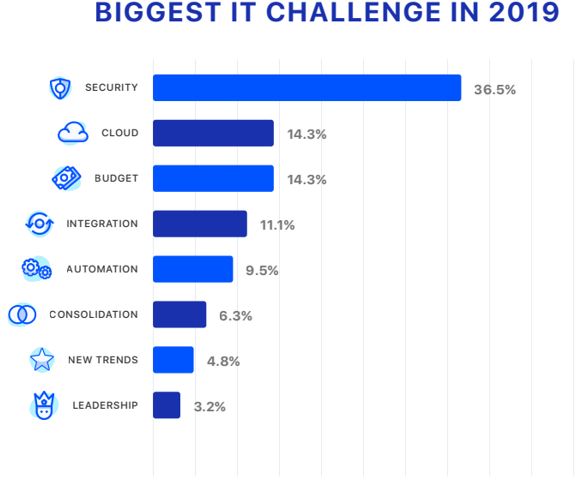 It seems like ancient history, but once upon a time, your IT team actually controlled all the business software used in your company. No product adoption took place without their oversight. They knew which programs were installed on which servers and who was using which tools. They had their finger on the pulse of everything that happened in the company’s digital world, because nothing changed unless they saw to it. But today, that’s all changed.
It seems like ancient history, but once upon a time, your IT team actually controlled all the business software used in your company. No product adoption took place without their oversight. They knew which programs were installed on which servers and who was using which tools. They had their finger on the pulse of everything that happened in the company’s digital world, because nothing changed unless they saw to it. But today, that’s all changed.
Raised in the digital age, millennial employees are comfortable hunting for an app that helps them to complete the tasks in front of them, registering for it, and simply getting on with their work. If their chosen tools don’t turn out to serve the purpose they had hoped, they’ll just move on to a replacement. Business apps are easy to find, are accessed via the web so they don’t need to be downloaded or configured, many are free and can be used more or less immediately, so there’s no effort involved in trying multiple tools.
As a result of this ease of use, IT teams have lost their monopoly over business software, which isn’t a problem unto itself. But in order to thrive in 2019, companies need to be vigilant about budget waste, cybersecurity vulnerabilities, data privacy regulation compliance and collaboration-killing silos. So IT managers need solutions that can help them know exactly what SaaS apps are in the mix, and to get involved with managing the entire life cycle of each app’s use in the business.
That’s why today’s IT managers are increasingly turning to tools like Torii, which helps them to audit app usage and access permissions; to run reports on license costs and use frequency; to receive instant alerts when an app nears license renewal or when an employee onboards a new app; and automate custom workflows that control SaaS login access as needed by the workplace.
SaaS Management Platform by Torii from Torii on Vimeo.
But is all this really necessary? Do IT managers and business owners need to invest time and energy in consolidating their view of the business tools used in the company? Isn’t “SaaS to manage Saas” just adding another layer of complexity to contend with?
These are good questions, and we have good answers. Here are some of the main reasons why you need to run ongoing SaaS toolkit audits for your business.
1. Integrate your systems
When you are fully aware of which tools are in use in your business, you’ll be able to make better app and business tool choices moving forward. Visibility into your existing stack means that you can ensure that all your new tools integrate smoothly with your current toolkit, enabling you to build a coefficient stack that is greater than the sum of its parts.
Furnishing your employees with business tools that integrate well together encourages improved collaboration, helping everyone to share data effectively and avoid siloing.
A well-coordinated toolkit is a crucial stepping stone to systems integrations, which IT managers have listed as one of their top challenges. This is key to increasing efficiency and output throughout the enterprise.

2. Raise compliance levels
In our business world, data keeps multiplying exponentially, while compliance regulations are mushrooming. Your business won’t get a second chance if there’s a data breach. GDPR was just the vanguard; CCPA is on its way too, and the New York state legislature is discussing the New York Privacy Act.
Compliance with these various regulations is a complex process that requires steps like appointing a data protection officer, clarifying your methods for gathering consent, and shoring up security on data archives, but none of those are much use if you don’t know where your data is located and with which third-party software companies it’s being shared.
Without knowing which apps can access and store what data resources, you can’t even begin to ensure compliance.
3. Get more bang for your buck
If you aren’t sure who is using what in your SaaS toolkit, you have no way of knowing if two employees are using competing apps that perform more or less the same functions.
If this is the case, you could be paying the license fee for two parallel tools, instead of paying just one fee for multiple employee access.
What’s more, you could be paying monthly or annual fees for an app that’s used by just one employee, twice a year, because you are unaware that usage has dropped. It’s possible you didn’t even know that you were paying for this app in the first place.
4. Close security wormholes
Every app in use at your business is another potential entrance for hackers and cyberthieves. If your employees have unlimited freedom to use any SaaS app they like, you face a huge threat of creating a shadow IT situation, when your IT team is unaware of vulnerabilities within the ecosystem.
However, you also don’t want to prevent employees from choosing the tools that they feel best suit the tasks they face, are most comfortable using, and that best increase their efficiency. The only way to avoid a shadow IT showdown is for IT managers to vet and approve SaaS apps as quickly as possible, to maintain flexibility for employees to pick the right tool for each situation.
Full visibility into your SaaS toolkit slashes the time it takes to recognize any needs to vet and approve new apps, allowing the business to remain agile and able to respond to market changes quickly, without compromising on cybersecurity.
5. Turn off employee access
One of the most common causes of company data misuse is from disgruntled former employees who still have access to resources. To prevent this scenario, you need to be sure that workers who leave your business immediately lose access to business data and apps.
If you don’t know what apps they are using or which permissions they’ve set up for remote working, you won’t be able to prevent them from exposing business secrets, leaking confidential customer data, or accidentally opening up a security vulnerability.
This works just as well in reverse, although the stakes are not so high. Onboarding new employees is a lot faster and more streamlined when you know which apps they’ll need to access. You can breeze through it all in just a click or two, but only if you’re aware of what’s out there.
Visibility into your SaaS ecosystem is a must-have
Knowing which SaaS tools are in use across your company, how many employees are using each one, and which access permissions are currently set up is no longer nice-to-have. It’s a must-have.
Your SaaS toolbox audit is your means to meeting compliance regulations, plugging security gaps, avoiding spending unnecessary bucks on redundant software, speedily onboarding and offboarding employees from the company IT system, and achieving the goal of systems integration.

